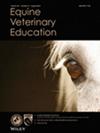Standing cone-beam computed tomographic digital flexor tendon sheath contrast tenography in 18 horses
Abstract
Background
Limited data exist on the benefits of using standing cone-beam computed tomography (CBCT) contrast tenography before tenoscopy of the digital flexor tendon sheath (DFTS).
Objectives
To document DFTS pathologies in a sample population and compare CBCT contrast tenography and radiographic tenography with tenoscopic or post-mortem findings.
Study design
This prospective study compared CBCT contrast tenographic findings with final tenoscopic diagnoses. Radiographic tenogram studies were retrospectively reviewed to assess agreement with CBCT and tenoscopic findings.
Methods
Between May 2022 and September 2023, 18 horses with DFTS-related lameness underwent radiographic contrast tenography, followed by standing CBCT and subsequently underwent tenoscopic or post-mortem examination. A retrospective, blinded assessment of radiographic tenograms was performed. No additional invasive procedures or adverse events occurred.
Results
Pathologies included deep digital flexor (DDF) tendinopathy (4 cases), manica flexoria (MF) tears (3), palmar/plantar annular ligament (PAL) constriction (6), superficial digital flexor (SDF) tendinopathy (4) and straight sesamoidean ligament (SSL) enthesopathy (1). CBCT detected all DDF tendinopathies and correctly identified two of three MF tears. CBCT accurately identified two of four SDF lesions and six of seven cases afflicted only by PAL constriction. SSL enthesopathy was detected on CBCT and post-mortem. No pathology was detected radiographically but was not detected by CBCT. Misclassified cases on CBCT were similarly misclassified radiographically. CBCT detected a DDF tendinopathy, SDF tendinopathy and SSL enthesopathy that were not acknowledged on radiographic tenography. Inversely, a radiographically suspected MF tear was not considered present on CBCT, and the MF was confirmed to be normal at tenoscopy.
Main limitations
Small sample size, subjective interpretation of CBCT and tenoscopic findings, and lack of ultrasound comparison.
Conclusions
Standing CBCT contrast tenography shows promise in identifying DFTS pathologies, especially in cob-type horses, potentially improving surgical planning and reducing costs. Further studies are needed to validate these findings.




 求助内容:
求助内容: 应助结果提醒方式:
应助结果提醒方式:


